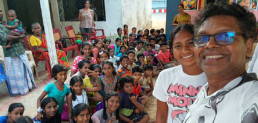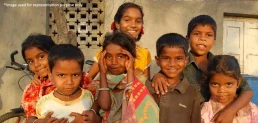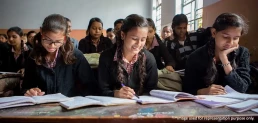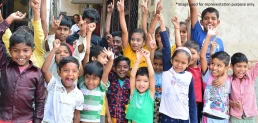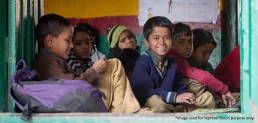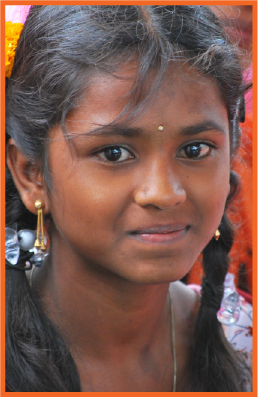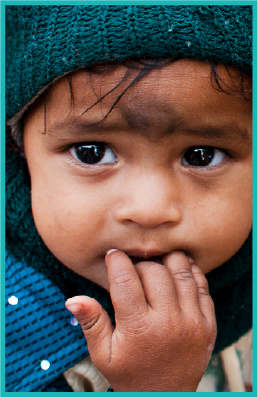CRY America Donor Edward Remias’ trip to Project PORD.
During a recent trip to Tamil Nadu, I visited Project RWDS in Ramnathapuram district, which focuses on the palm grove workers who tap palm trees to sell jaggery, for their livelihoods. Accompanied by my wife, Jyothi, and our daughter, Nitya, we were deeply moved by their struggles, particularly the debt cycle that limits their children's education. Nitya’s comparison to the post-reconstruction plight of slaves highlighted the urgency for change.
These workers spend 7 to 8 months in groves far from their villages, with children often missing school, leading to dropouts. Project RWDS serves as a lifeline for these families. They work to keep children in school. It was great to visit a new school in Sengazhaneerodai, built after 14 years of community campaigning. Previously, children traveled 20 kms to school. The new school has 2 classrooms for grades 1 to 5 & provides mid-day meals.
At a nearby development center, we were greeted with song & dance by the children. Nitya, who has recently opened a CRY chapter at her school, engaged with the children from a world so different from hers.
As we drove away, we felt immensely changed. Meeting Mr. Sathaiah & his dedicated team left us inspired to do more, a sentiment I know resonates with Jyothi and Nitya as well. Visiting a CRY project is an eye-opening experience that sheds light on the resilience of communities and CRY’s belief in the power of collective action for change.
Project RWDS Impact 2024
- 1,196 children retained in schools
- 21 children removed from labor & enrolled in school
- 252 children (98%) cleared 10th grade
- 440 children benefited from life skill sessions
Supplementary classes conducted regularly for 107 children
Thank You to Mukund Padmanabhan & Gurukrupa for their generous support of $30,000 to Project RWDS in FY 2024. Your support has enabled this impact in the lives of underprivileged children and we are truly grateful.
10 Ways to Combat Gender Stereotypes in India
Gender stereotypes shape societal norms and limit opportunities for individuals. Challenging these biases is essential for creating a more inclusive and equal society. Here’s how different sectors can contribute to combating gender stereotypes in India.
Understanding Gender Stereotypes: What Are They?
Gender stereotypes are preconceived notions about the roles, traits, and behaviours expected from men and women. These stereotypes often reinforce discrimination and restrict individuals from pursuing opportunities beyond traditional roles.
How Gender Stereotypes Impact Individuals and Society
Here are some ways gender stereotypes impact individuals and society:
- Limited career opportunities: Women are often discouraged from STEM fields, while men face stigma in caregiving roles.
- Workplace discrimination: Gender pay gaps and biases in hiring persist in many industries.
- Social conditioning: Cultural norms reinforce traditional expectations, affecting personal choices and aspirations.
Also Read: The Importance of STEM Education
Why Addressing Gender Stereotypes is Essential for Progress
Breaking gender stereotypes leads to:
- Economic growth: A diverse workforce enhances productivity and innovation.
- Better education outcomes: Encouraging all genders to explore various fields promotes balanced development.
- Improved societal well-being: Gender equality fosters healthier relationships and reduces discrimination.
Breaking the Cycle: How Education Can Eradicate Gender Stereotypes
Education plays a powerful role in shaping perceptions and dismantling gender stereotypes from an early age. Schools, colleges, and teachers can actively work toward creating an inclusive learning environment. Here’s how:
- Introducing gender-neutral curricula and diverse role models to challenge biases.
- Encouraging critical thinking so students question societal norms.
- Training teachers to recognise and address gender-based discrimination in classrooms.
Also Read: What is Gender Inequality
Role of Parents and Families in Combating Gender Stereotypes
Parents have the responsibility to nurture an environment that allows children to explore their interests freely without being bound by stereotypes. Some other ways are:
- Encouraging children to pursue interests beyond gender norms and develop diverse skills.
- Sharing household responsibilities equally sets an example of gender balance.
- Avoiding gender-biased language and reinforcing respect for all professions.
Media's Influence on Gender Norms and Ways to Create Change
The media has a significant influence on shaping societal perceptions of gender. From advertisements to films, the way gender is represented affects how people perceive their roles in society. Changing these narratives can help in combating gender stereotypes effectively.
Empowering Women and Men to Challenge Stereotypical Roles
Women are often expected to take on caregiving roles, while men are pressured to be sole providers. Challenging these norms is essential for creating a more balanced society. Here’s how you can do this:
- Encouraging individuals to pursue careers and interests beyond traditional expectations.
- Promoting gender-inclusive policies at workplaces and educational institutions.
- Creating platforms for open discussions on gender equality and breaking biases.
Advocating for Equal Opportunities in Workplaces and Schools
Workplaces and educational institutions play an important role in shaping gender perceptions. Ensuring equal opportunities allows individuals to excel based on merit rather than outdated societal norms. To do this:
- Implementing unbiased hiring and promotion policies to close gender gaps.
- Providing mentorship programs that support women and underrepresented groups in leadership roles.
- Encouraging schools to include gender sensitivity training in their curriculum.
Addressing Gender Stereotypes in Rural and Urban India
While rural areas often adhere to traditional roles due to cultural norms, urban spaces also face challenges like workplace biases and unequal household responsibilities. Addressing these disparities requires targeted efforts. Here’s how you can do this:
- Expanding education and vocational training programs for women in rural areas.
- Encouraging men to take an active role in household responsibilities.
- Promoting awareness campaigns that challenge gender biases in both settings.
The Role of Cry America in Combating Gender Norms
Organisations like CRY America play a significant role in advocating for gender equality. Through their initiatives, they support children's education, empower women, and challenge deep-rooted societal biases. Their efforts include:
- Running programs that provide girls with access to quality education.
- Working with communities to change perceptions around gender roles.
- Supporting policies that promote gender equality at the grassroots level.
How to Create a Supportive Environment for Future Generations
To ensure a future free from gender stereotypes, we must create an environment where children grow up with the freedom to choose their paths without societal restrictions. This involves collective efforts from families, educators, and policymakers.
FAQs
How can education help in combating gender stereotypes?
Education plays a key role in combating gender stereotypes by promoting gender equality from an early age. Schools can introduce gender-neutral curricula, highlight contributions from all genders in various fields, and encourage students to challenge biases. Training teachers to address stereotypes in classrooms also helps create an inclusive environment.
What role do parents play in breaking gender stereotypes?
Parents are the first influencers in a child’s life and play a crucial role in how to combat gender stereotypes at home. Encouraging children to explore interests beyond traditional gender roles, sharing household responsibilities equally, and avoiding gender-biased language help in shaping progressive mindsets.
How can the media contribute to reducing gender stereotypes in India?
The media has the power to reshape societal norms by portraying diverse and balanced gender roles. Promoting positive and realistic representations of women and men in films, advertisements, and news stories helps combat gender stereotypes. Media campaigns that challenge traditional norms and highlight gender equality can further accelerate change.
What are some examples of policies in India that address gender stereotypes?
Several Indian policies focus on combating gender stereotypes:
- Beti Bachao Beti Padhao – Encourages education and empowerment of girls.
- POSH Act (2013) – Addresses workplace harassment and promotes gender equality at work.
- Gender Budgeting – Ensures government policies consider gender perspectives.
- These initiatives work towards dismantling deep-rooted biases in society.
Are gender stereotypes more prevalent in rural or urban India?
Gender stereotypes exist in both rural and urban areas, though they manifest differently. Rural regions often see stronger traditional roles due to cultural norms and limited education. Urban India, while more progressive, still faces biases in workplaces, media, and societal expectations. Addressing stereotypes in both settings requires targeted efforts in education, policy-making, and media representation.
How Education Can Break The Cycle Of Child Marriage
To unlock the power of education in breaking the cycle of child marriage, it’s critical to reassess who we are educating and what we are teaching them. As education is synonymous with awareness, will it suffice to simply provide educational resources as child marriage solutions without educating parents and families on their value? Child marriage is never a child's dream but an unchosen reality imposed by societal and financial circumstances.
To drive sustainable change that eliminates child marriage, we need to focus on the root causes that give rise to this issue, robbing children of their childhood. This article explores the reciprocal relationship between lack of education and child marriage, how education can combat it, key implementation strategies, and the challenges that remain.
Understanding The Relation Between Child Marriage And Lack Of Education
Child marriage is a human rights violation that hinders girls from realizing their full potential. This harmful practice is strongly linked to a lack of education, poor health, limited access to resources, and gender inequity. One of the most significant consequences is the abrupt end to schooling that often follows child marriage.
In many developing countries, marriage and education are seen as incompatible, with decisions to withdraw a girl from school and marry her off frequently occurring simultaneously. These choices are largely shaped by societal perceptions of education’s value and the availability of job opportunities for educated girls.
Education as a tool to prevent child marriage
The concept of using education as a tool to prevent child marriage is twofold. While it is important to ensure access to education for girls so they can enroll and complete their studies, the first step begins with educating their families and communities, who serve as key decision-makers in underserved households.
Educating parents and households
To determine what parents and households need to be educated about, we must first examine the underlying factors that compel families toward early marriage. Deeply rooted in harmful gender norms and widespread poverty, child marriage often becomes a survival strategy to escape from financial burdens.
Empowering communities through education, economic support, and awareness programs can help break the cycle of child marriage. It can only be achieved by educating them on the long-term consequences of child marriage, highlighting the health risks that could be involved. Providing financial incentives for girls’ education, linking families with livelihood opportunities, and ensuring legal enforcement against early marriage, alongside shifting societal norms through advocacy, can create sustainable change and protect girls' rights and futures.
Educating girls and adolescents
According to UNICEF’s 2022 global report, The Power of Education to End Child Marriage, completing secondary school could reduce child marriage rates world-wide by two-thirds (66%). Keeping girls in school is a proven strategy for child marriage prevention.
Empowering girls with education about the health risks of early pregnancy and the cycle of poverty linked to child marriage is crucial in helping them make informed life choices.
Key Strategies For Preventing Child Marriage Through Education
To end child marriage, girls and their families must envision a brighter, more promising future. Education, widely recognized as the most effective factor in delaying marriage, provides this opportunity. The key strategies to combat child marriage through education are:
Ensure girls complete secondary education
While primary schools are still abundant in underserved regions, access to secondary education remains a significant challenge for girls. Quality education, particularly at the secondary level, imparts knowledge, develops skills, and empowers girls to pursue employment.
We must ensure the availability of quality education resources and the efforts needed to enable girls to attend secondary school through mass awareness campaigns and targeted interventions.
Provide vocational and life skill training to girls
By linking girls to vocational programs like tailoring, nursing, driving makes them financially sustainable to support their own education. Besides this, teaching girls basic skills like literacy, numeracy, communication, health management, problem-solving, and financial literacy, they can become more confident and capable. Connecting with peers through capacity-building initiatives and mentors also helps reduce social and economic isolation.
Educate and engage parents and community members
Families and community leaders typically decide when and whom a girl marries. Educating them through meetings, door-to-door visits, or public announcements about gender equity and the impacts of child marriage on a girl's health and future can drive change. With this knowledge, adults' attitudes shift, making them more likely to challenge traditional expectations.
Provide economic support and incentives for girls and families
Parents may marry off daughters early for financial reasons mainly to reduce household expenses. Economic support for low-income families can help reduce child marriage. Offering incentives like educational loans, scholarships, or employment opportunities for parents can provide immediate relief and increase a girl's perceived value through skills that lead to future income.
Challenges Of Preventing Child Marriage
The biggest challenge of child marriage is the lack of educational awareness in communities, perpetuated by deep-rooted poverty. While child marriage prevention strategies, targeted interventions, and quality education can help stop forced child marriages, they have limited power to prevent early marriages resulting from mutual understanding between families. These practices can only be uprooted when there is a dynamic shift in community attitudes through constant awareness sessions, allowing them to break free from the constraints of gendered parenting. Another significant challenge is the presence of societal traditions that pushes parents to marry off their girls early led by the fear of community judgements. It can only be eradicated when the entire community is enlightened on the consequences of child marriage including health-risks, and the opportunities the girls are missing out when they stay out of schools.
Cry America’s Efforts To Combat Child Marriage Through Education
By empowering communities and families through education, awareness campaigns, and engagement, CRY America aims to break the cycle of child marriage and create opportunities for children to lead independent lives.
- Adolescent girls' collectives: Forms collectives to educate communities on the health, social, and legal impacts of child marriage.
- Awareness campaigns: Organize targeted campaigns to raise awareness about the consequences of child marriage for families and children.
- Connecting to government programs: Links children to government initiatives, providing them with educational opportunities.
- Empowering families with employment opportunities: Guides families toward income-generating options like kitchen gardening and other employment programs to reduce financial pressures.
- Enrolling and re-enrolling children in schools: Counsels families and potential child brides through targeted interventions to enroll or re-enroll in school and organizes support classes to help children bridge the educational gap.
- Conducting vocational programs: Links adolescent girls with different vocational programs to groom them with essential skills and provide them an exposure.
Cry America Preventing Child Marriage Through Targeted Intervention
While working with the Kalapandhari Magas Vargiya and Adivasi Gramin Vikash Sanstha (KMAGVS) project in Maharashtra, CRY America encountered an adolescent girl, Nandini*, who had been forced to drop out of school in 9th grade and marry early due to financial constraints.
As a member of KMAGVS’s children’s collective, she was counseled by the team to participate in community radio broadcasts on Akashvani, organized by the project members. Gaining confidence and support, she began advocating for girls’ education and sharing her views with her community. The project team also worked with her parents, emphasizing the importance of education, eventually convincing them to cancel her early marriage and re-enroll her in school.
The 16-year-old girl went on to excel in her 10th board exams, securing the first rank in her school.
Name changed to protect child’s identity.
Conclusion
India has made significant progress in reducing child marriage, with the percentage of child marriages falling from 49% in 1993 to 22% in 2021, according to Harvard School of Public Health. However, the journey is far from over. CRY America continues to tackle the cultural, financial, and social barriers that sustain child marriage.
By supporting CRY America, you can help protect children from the harmful effects of child marriage. Donate now to make a lasting impact and help us end child marriage together.
Understanding Child Labor In India: Facts, Causes, And Consequences
Going to school may not be a reality for every child. For many children, school is a privilege and not a promise. Though significant progress has been made through rigorous efforts, much work remains to address the economic reasons for child labor and eradicate it from the grassroots.
In today’s blog, let’s understand child labor by exploring its different forms, causes and consequences, fact,s and statistics, and the key efforts needed to address it.
What Is Child Labor?
Child labor involves children aged 5-14 engaged in work that jeopardizes their physical, mental, or emotional well-being. It deprives them of their childhood, dignity, and education. This includes hazardous tasks, work that disrupts their schooling, and circumstances that force them to drop out. Besides disrupting education, it also leaves a lasting impact on their growth and development.
Types Of Child Labor
There are various forms of child labor, with the key ones being:
Agricultural labor
According to the UNICEF Global Report 2024, agriculture is the most prevalent form of child labor, affecting both boys and girls. Around 70% of children engaged in child labor worldwide work in farming or related activities. These children endure hazardous conditions, including exposure to harmful chemicals, operating dangerous machinery, and working long hours under the sun.
Domestic labor
The International Labor Organization (ILO) Global Database 2024 states that 67.1% of child domestic workers are girls employed in households. They perform tasks such as cleaning, cooking, and caring for younger children.
Manufacturing and small-scale industries
Children working in manufacturing and small-scale industries like textiles, brick kilns, and mining often face hazardous conditions. They are often exposed to toxic substances, operate heavy machinery, and perform physically demanding tasks.
Street and service sector
Many children work as street vendors, shoe shiners, or in small eateries. They endure long hours, harsh conditions, and high risks of exploitation, abuse, and trafficking due to the unregulated nature of their work.
Causes Of Child Labor In India
Several socio-economic factors contribute to the persistence of child labor in India. The primary factors contributing to the cause are:
- Lack of parental awareness: Families struggling to meet their basic needs often lack awareness of the importance of education and push their children to work.
- Unemployment and underemployment of parents: When parents lack stable employment, they involve their children to support their livelihood.
- Lack of access to quality education: Poor school infrastructure, a lack of adequate schools in remote areas, and the inability to afford study materials deter children from attending school.
- Cultural and social norms: In some communities where education seems out of reach, child labor is normalized due to a lack of community awareness.
Statistics Of Child Labor In India
India has made significant efforts to combat child labor through laws like the Child Labor Amendment Act 2016, digital education initiatives like DIKSHA, and the enforcement of Mid-Day Meal programs that ensure children’s retention in schools. According to the International Labour Organization (June 2017), child labor in India dropped by 2.6 million between 2001 and 2011. While rural areas saw a decline, urban areas experienced a rise due to increasing demand for child workers in menial jobs.
Industries And Sectors Where Child Labor Is Prevalent
Child labor persists in industries with a high demand for cheap labor. Here are the industries most affected by child labor practices.
- Agricultural sector: In countries that depend primarily on agriculture for livelihood, children are often seen working in harvesting fields.
- Textile and garment industry: Small-scale industries prefer hiring children because their nimble fingers can handle delicate embroidery and weaving, and they can be paid lower wages.
- Brick kilns and construction sites: Children are used for carrying bricks and mixing cement because they are easily controlled and less likely to demand fair wages or working conditions.
- Firecracker and matchstick factories: The demand for low-cost labor and lack of safety regulations make children vulnerable to hazardous environments.
- Hospitality and domestic work: Employers prefer child labor in homes and small businesses as they can be overworked and underpaid without legal consequences.
Unemployment And Underemployment Of Parents
Child labor stems from parents' unstable income, forcing children to work. Rescuing them is futile without sustainable family income. Without economic security, rescued children are often forced back into labor. Vocational training programs, employment benefits, and government welfare programs aimed at improving parental income are essential to prevent relapse into labor, ensure economic security, and keep children in school.
Consequences Of Child Labor On Children’s Wellbeing
Here are the long-term physical & mental consequences of child labor on children’s well-being.
Physical health risks
- Chronic pain: Heavy lifting in brick kilns, agriculture, and domestic work leads to chronic back and joint pain.
- Respiratory issues: Exposure to dust and fumes in mines and factories causes asthma, silicosis, and bronchitis.
- Skin disorders: Handling toxic substances results in burns, allergies, and chronic skin conditions.
- Cancer risk: Carcinogen exposure in chemical factories and mining increases cancer risks.
- Reproductive health issues: Pesticides and chemicals cause infertility and long-term health complications.
- Malnutrition & growth impairment: Poor nutrition and harsh conditions result in stunted growth and weak immunity.
- Vision problems: Fine-detail work in embroidery and electronics leads to eye strain and vision impairment.
- Permanent disabilities: Accidents in hazardous workplaces often cause amputations or fractures.
Mental health risks
- Anxiety & depression: Stressful conditions in agriculture and factories lead to emotional distress.
- PTSD: Harsh work environments contribute to long-term emotional trauma.
- Low self-esteem: Constant exploitation fosters feelings of worthlessness.
- Cognitive delays: Lack of education affects intellectual development.
- Social isolation: Missing childhood experiences hampers relationship-building.
- Substance abuse: Exposure to stress and trauma increases the risk of addiction.
Cry America’s Efforts In Eliminating Child Labor
CRY America identifies and rescues child laborers reclaim their childhood and secure a brighter future through campaign drives and targeted interventions:
- Identifying child laborers: Identifying and rescuing child laborers, forming child and adolescent collectives to ensure immediate safety.
- Linking with government programs: Linking children to scholarships and educational programs while connecting parents to stable jobs like MNREGA to prevent child labor.
- Integrating children into mainstream education: Counseling children to resume schooling and reintegrate into mainstream education.
- Organising life skill sessions: Helping children develop focus, resilience, and emotional recovery through skill-building sessions.
- Bridging learning gaps: Conducting support classes to help children catch up on missed education.
- Sports coaching: Teaching discipline, patience, and confidence through sports, allowing children to rediscover the joys of childhood.
Conclusion
Over the past two decades, India has made significant progress in reducing child labor. However, the fight is far from over and requires continued efforts and support from compassionate individuals like you. Donate now to help liberate children and give them a promising future filled with hope.
How NGOs Are Driving Access to Quality Education for Children in Rural India
Access to quality education is a major challenge for children in rural India, where a lack of infrastructure, resources, and awareness often prevents them from realizing their full potential.
Non-governmental organizations (NGOs) are an important factor in bridging this gap. Through their tireless efforts, NGOs are improving access to education and ensuring that children from rural areas receive holistic, and empowering education. Keep reading to know more!
The State of Education in Rural India: Challenges and Opportunities
Despite some progress, the state of education in rural India remains dire. Many of the population still lack access to quality educational facilities and resources. Schools often face challenges such as poor infrastructure, lack of trained teachers, outdated teaching materials, and high dropout rates.
However, opportunities for change do exist. With the right support, rural areas can use resources like digital learning, government initiatives, and community engagement to bridge the gap and provide better opportunities for children.
Key Barriers to Education in Rural Areas
Rural areas face multiple challenges that limit access to quality education:
- Geographical Barriers: Many children travel long distances to reach the nearest school, often facing transportation and safety concerns.
- Poverty: Financial constraints often force children to work instead of attending school. Many families prioritize earning over education, making it difficult for children to access education.
- Gender Disparity: Cultural norms may restrict girls' access to education, limiting their personal and professional growth opportunities.
- Lack of Infrastructure: Schools in rural areas often lack basic amenities such as clean water, sanitation, and electricity, making learning conditions difficult.
- Inadequate Teaching Resources: A shortage of qualified teachers and teaching materials hampers the quality of education children receive.
Why Quality Education is a Game-Changer for Rural Communities
Quality education can break the cycle of poverty in rural communities. It enables children to gain essential life skills, develop critical thinking, and enhance problem-solving abilities.
Quality education helps rural children secure better employment and contribute meaningfully to their communities by offering higher education and skill-building opportunities. Moreover, educated individuals often lead social change, fostering gender equality, improved healthcare, and enhanced economic development in their regions.
How Cry America Are Bridging the Gap in Rural Education
CRY America has been at the forefront of improving rural education in India. Through its comprehensive approach, the organization is working tirelessly to provide children in rural areas with the resources, education, and support they need to thrive. CRY focuses on:
- Mobilizing Communities: Engaging communities to recognize the value of education and encouraging parental involvement in children's learning.
- Teacher Training and Support: Ensuring that rural schools have well-trained, motivated, and skilled teachers who can provide quality education.
- Building Infrastructure: CRY works to improve the physical infrastructure of rural schools, providing essential resources like clean drinking water, sanitation, and safe classrooms.
- Policy Advocacy: Advocating for better policies and systems to ensure that the government’s educational resources are utilized effectively in rural areas.
Innovative Programs Led by Cry America to Enhance Rural Education
CRY America’s innovative programs have had a profound impact on rural education:
- Digital Learning Initiatives: CRY has introduced e-learning programs to overcome the lack of access to education resources. Rural children can access lessons, educational videos, and otherwise unavailable resources through mobile-based applications and digital classrooms.
- Gender-Sensitive Programs: CRY focuses on empowering girls and runs gender-sensitive education programs that encourage parents to send their daughters to school and support their continued education.
- Community-Based Learning Centers: To address the lack of school infrastructure, CRY has set up learning centers in remote areas where children can access quality education in safe environments.
Real-Life Success Stories: How CRY America Is Making a Difference
CRY America’s Project Pragathi has had a significant impact on the Chittoor district of Andhra Pradesh. It has addressed the key issues of school dropouts, child labor, and early childhood education. By improving the skills of Anganwadi teachers, sensitizing parents, and working with children’s collectives, this project has made remarkable strides in creating lasting change for children in the area.
The impact? The project has transformed 174 centers into Model Anganwadi centers, ensuring that early childhood education is provided to children above 3 years old. It has also trained 60 Anganwadi teachers in the Early Childhood Care and Education (ECCE) program, thus improving the overall quality of preschool education in the region.
FAQs
How is technology helping to improve access to education in rural areas?
Technology bridges the education gap in rural areas by providing digital learning platforms, smart classrooms, and mobile-based education. Initiatives like online courses, virtual tutoring, and e-libraries help students access quality learning resources despite geographical limitations.
How can individuals support NGOs working for education in rural India?
Individuals can contribute by donating funds, or spreading awareness. Supporting NGOs through corporate partnerships or volunteering can also have a significant impact.
What role does the government play in enhancing education in rural India?
The government implements policies, scholarships, and infrastructure programs to improve education access. Initiatives like Samagra Shiksha Abhiyan, mid-day meal schemes, and digital learning projects aim to bridge the rural-urban education divide.
Why is quality education important for children in rural India?
Quality education equips children with knowledge, critical thinking skills, and better job opportunities, helping them break the cycle of poverty. It also promotes social development, gender equality, and economic growth in rural communities.











